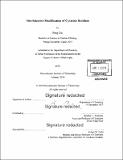| dc.contributor.advisor | Bradley L. Pentelute. | en_US |
| dc.contributor.author | Dai, Peng, Ph. D. Massachusetts Institute of Technology | en_US |
| dc.contributor.other | Massachusetts Institute of Technology. Department of Chemistry. | en_US |
| dc.date.accessioned | 2018-05-23T16:35:06Z | |
| dc.date.available | 2018-05-23T16:35:06Z | |
| dc.date.copyright | 2018 | en_US |
| dc.date.issued | 2018 | en_US |
| dc.identifier.uri | http://hdl.handle.net/1721.1/115793 | |
| dc.description | Thesis: Ph. D., Massachusetts Institute of Technology, Department of Chemistry, 2018. | en_US |
| dc.description | Cataloged from PDF version of thesis. | en_US |
| dc.description | Includes bibliographical references. | en_US |
| dc.description.abstract | Proteins are biomolecules that carry out essential work in cells and are required for the structure, function, and regulation of biological systems. It is desired to install designer modifications on proteins of interest, in a site-selective manner mimicking nature's post-translational modifications, for various biological and therapeutic applications. Towards this goal, efforts were devoted to develop site-selective protein modification methods. The [pi]-clamp-mediated cysteine perfluoroarylation, a novel sequence-selective protein modification strategy, enabled regioselective cysteine modification in the presence of competing cysteines on protein surface. The major goals of this thesis include improving and understanding the [pi]-clamp-mediated reaction, and discovering new sequence-selective protein modification chemistries. Aiming to improve the n-clamp-mediated site-selective protein modification, the effect of inorganic salts is discovered. Salt in aqueous solution significantly changes the reaction rate of [pi]clamp-mediated cysteine bioconjugation over four orders of magnitude, enabling fast and sitespecific modification of proteins including antibodies. The salt effect on n-clamp-mediated arylation is concentration-dependent and ion-specific following the Hofmeister series. Salts composed of early member ions in the Hofmeister series accelerate the reaction, while late members decrease the rate. To understand the unique self-labelling reactivity of the n-clamp tetrapeptide (Phe-Cys-Pro-Phe), mutational, computational, and structural investigations are carried out. Our findings suggest several structural and chemical features contribute to the unique reactivity of [pi]-clamp including the trans prolyl amide bond, lowered reaction enthalpy of activation ([delta]H**), reduced cysteine pKa and side chain-perfluoroaryl electrophile interactions. A sequence-selective thiol-yne reaction is discovered. The seven-residue peptide tag (DBCO-tag, Leu-Cys-Tyr-Pro-Trp-Val-Tyr) can selectively react with various azadibenzocyclooctyne (DBCO) reagents. To demonstrate the sequence-selectivity, this reaction is applied to site-selective cysteine modificaition in proteins bearing more than one cysteine residue. In addition, organometallic palladium oxidative addition complexes bearing O-phenyl carbamate are developed for protein crosslinking between cysteine and lysine residues. A glutathione S-transferase (GST) catalyzed site-selective macrocyclization reaction for peptides up to 40 amino acids in length is also reported. | en_US |
| dc.description.statementofresponsibility | by Peng Dai. | en_US |
| dc.format.extent | 257 pages | en_US |
| dc.language.iso | eng | en_US |
| dc.publisher | Massachusetts Institute of Technology | en_US |
| dc.rights | MIT theses are protected by copyright. They may be viewed, downloaded, or printed from this source but further reproduction or distribution in any format is prohibited without written permission. | en_US |
| dc.rights.uri | http://dspace.mit.edu/handle/1721.1/7582 | en_US |
| dc.subject | Chemistry. | en_US |
| dc.title | Site-selective modification of cysteine residues | en_US |
| dc.type | Thesis | en_US |
| dc.description.degree | Ph. D. | en_US |
| dc.contributor.department | Massachusetts Institute of Technology. Department of Chemistry | |
| dc.identifier.oclc | 1036988120 | en_US |
